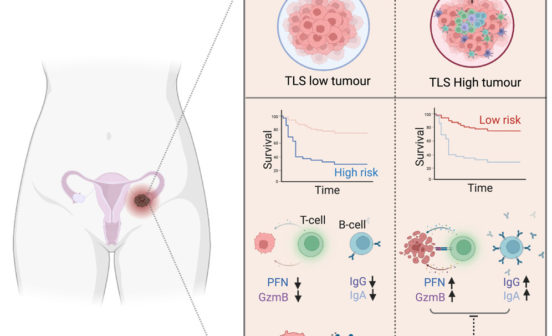Prevention Newly Discovered DNA Architecture Offers Breakthrough in Reversing Ovarian Cancer Drug Resistance

An unusual DNA structure may hold the key to treating one of the deadliest cancers affecting women, which claims over 200,000 lives globally each year. Most women with ovarian cancer respond very well to chemotherapy at first, but in 70% of cases, the cancer grows back. And although many patients will respond to chemotherapy a second or third time, eventually the drugs will stop having an effect.
In a new study led by the Institute of Chemical Biology-CDT PhD students Gem Flint and Dr Jenna Robinson, reveal how four-stranded DNA structures, known as G-quadruplexes, could be targeted to reverse chemoresistance in ovarian cancer. This approach could potentially restore the effectiveness of chemotherapy in patients who no longer respond to treatment.
“It’s been a fantastic opportunity to work on such an exciting project as part of my PhD,” said Gem Flint. “Chemotherapy resistance is a major challenge for ovarian cancer patients, so having the opportunity to contribute to the scientific understanding of how this resistance may develop has been incredibly rewarding.”
These findings lend to collaborative research led by Dr Marco Di Antonio (Department of Chemistry) with Professor Hector Keun and Professor Iain McNeish (Department of Surgery & Cancer) at Imperial College London, who now head the team working to translate these insights into new treatment strategies.
While most DNA exists in the familiar double helical form, it can also adopt alternative configurations under certain conditions. One such structure, rare but functionally significant, is the quadruple helical structure known as G-quadruplex. These four-stranded DNA arrangements were initially thought to be only a structural oddity.
Dr Jenna Robinson commented: “It’s incredibly exciting to understand more about how cancer cells become resistant to drugs. Drug resistance has been a major challenge in cancer treatment for decades, and whilst we’ve learnt a lot, cancers continue to surprise us with the many ways they adapt and evolve.”
While most DNA exists in the familiar double helical form, it can also adopt alternative configurations under certain conditions. One such structure, rare but functionally significant, is the quadruple helical structure known as G-quadruplex. These four-stranded DNA arrangements were initially thought to be only a structural oddity.
Dr Jenna Robinson commented: “It’s incredibly exciting to understand more about how cancer cells become resistant to drugs. Drug resistance has been a major challenge in cancer treatment for decades, and whilst we’ve learnt a lot, cancers continue to surprise us with the many ways they adapt and evolve.”
In recent years, researchers, including the Imperial team, verified that G-quadruplex DNA structures occur naturally in living human cells, particularly within regions that control gene expression. Building on this foundation, Flint and Robinson investigated the functional role of these structures in ovarian cancer cells, analysing how tumour cells change as they become resistant to chemotherapy.
They found that G-quadruplexes tend to accumulate in resistant cancer cells, forming within new regions of the genome, where enrichment of these structures was never observed before. DNA G-quadruplexes appear to substantially help ovarian cancer cells activate genes that counteract chemotherapy, effectively shielding the tumour from treatment. But the researchers also discovered their presence as a potential weakness. Indeed, by targeting the G-quadruplexes with specialised drugs, they were able to re-sensitise the resistant cells to standard therapies, thereby restoring the vulnerability of resistant cancer cells to chemotherapy.
Dr Marco Di Antonio commented: “This is an exciting discovery. For over a decade, we’ve known that G-quadruplex DNA can form in the genome, but this is the first time we’ve observed a functional response linked to targeting these structures—one that could be harnessed for therapeutic applications.
“With top ovarian cancer specialists at Imperial just down the road we can now fast-track investigating if these promising results can benefit patients.”
The Imperial team investigated the role of G-quadruplexes in ovarian cancer cells, analysing how tumour cells in the lab change as they become resistant to chemotherapy.
This research provides a promising new approach to treating patients with relapsed ovarian cancer and adds to growing evidence that DNA’s alternative structures could be powerful targets in the fight against diseases like cancer and neurodegeneration. The team is now working to establish if other cancers also harness DNA G-quadruplex structures to become resistant to chemotherapy, extending the relevance of this discovery.





